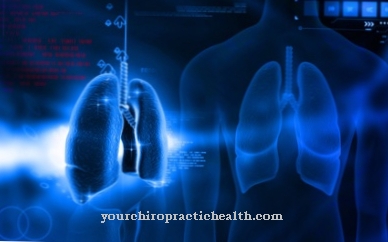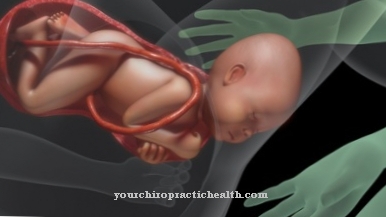The Chemoreception is a quality of perception of the sense of smell and taste and registers chemical substances in the air via chemoreceptors. The chemosensors measure, for example, the oxygen partial pressure and initiate breathing to avoid hypoxia. Chemoreception is impaired in patients with MCS (a minimal state of consciousness).
What is chemoreception?

Together with interoception, exteroception forms the entirety of the human perceptual system. In medicine, exteroception is the perception of external stimuli. Perception systems for this type of perception are the sense of sight, the sense of hearing, the sense of touch, and the sense of smell and taste.
The sense of smell and taste are closely linked and partially overlap during processing. Different perceptual qualities play a role for the sense of smell and taste. The chemoreception is sometimes the most important quality of perception in this area. This is a physiological process that binds chemical signals from the environment to chemoreceptors of the sense of smell and taste. For example, the presence of a particular molecule can initiate binding.
The chemoreceptors convert the stimuli into an action potential and make them accessible to the central nervous system. Chemoreceptors are located in the mucous membranes of the nose as well as in the oral mucosa. They specialize in the perception of airborne or liquid-dissolved chemicals and, last but not least, regulate breathing.
Humans have around 320 different chemoreceptors. Animals with a keen sense of smell have chemoreceptors for more than 1000 different chemical molecules.
Function & task
Chemoreceptors protect people from chemical substances in the air and in liquids. They are also involved in the regulation of breathing, the adjustment of the vascular tone and the regulation of the acid-base balance.
Medicine differentiates chemoreception into the perception by central chemoreceptors and the sensory impressions from peripheral chemoreceptors. Central chemoreceptors are located in the circulatory center of the brain stem (Formatio reticularis) and measure the pH value and the CO2 partial pressure of the brain water. Peripheral chemoreceptors are located in the glomera carotica and the glomera aortica. Your area of responsibility is the sensitivity for protons of the pH value, for potassium, for the O2 partial pressure and the CO2 partial pressure.
All peripheral chemoreceptors show a markedly high sensitivity for oxygen. When the O2 partial pressure falls below the so-called O2 threshold of 110 mm Hg, they excite the afferent nerves of the respiratory center and regulate vital respiration to prevent hypoxia.
Peripheral chemoreceptors are part of the glomus cells and represent clusters of vessels that are supplied with blood via the side branches of adjacent arteries. This blood circulation makes them one of the organs with the best blood supply. In connection with peripheral chemoreceptors, a distinction is made between type I and type II glomus cells. These cells are located bilaterally on the division sequence of the common carotid artery and in the aorta of the glomus aorticum. From this area they extend to the arteria subclavia dexter. Information about hypoxia travels as impulses to the vagus nerve and reaches the respiratory center via the glossopharyngeal nerve. In the respiratory center, breathing is initiated on the basis of this information.
In addition to the trigger zone of the chemoreceptors on the floor of the fourth ventricle within the area postrema, chemosensors are located in the mucous membrane of the gastrointestinal tract. These sensors play an important role in reflex vomiting. The sensors are sensitive to substances such as bacterial toxins, emetine, highly concentrated saline solution and copper sulfate. Although chemosensors are primarily responsible for interoception in the sense of the chemical measurement of liquids and gases in one's own body, they also protect people in the sense of exteroception from the consumption of certain substances from outside.
You can find your medication here
➔ Medicines against loss of appetiteIllnesses & ailments
A special position among the chemoreception-associated diseases is the multiple chemical intolerance. This is a symptom with severe intolerance to volatile chemicals such as fragrances, cigarette smoke, solvents or exhaust gases. For a long time it was discussed whether the disease should be assigned to psychosomatics or toxicology. According to recent studies, it is a multifactorial disorder with aspects of both fields.
MCS sufferers are particularly affected by tiredness, exhaustion, difficulty concentrating, headaches and burning eyes. In addition, they are often plagued by a loss of memory, shortness of breath, dizziness or complaints of the musculoskeletal system. Gastrointestinal complaints and dermatological problems can also occur.
Several theories have been put forward about the suspected causes of the disease. One of these theories states that the intolerance is due to work or environmental relationships and may be subject to genetic involvement. Poisoning, defective nerve and hormone functions or respiratory problems and the lowering of the nervous trigger threshold should play a causal role. In addition to solvents, chemical triggers include pesticides, metals and combustion products.
Other theories assume initial exposure to neurotoxic pollutants, which is associated with the unspecific symptoms of neurotoxic poisoning. After this first exposure, the effects are reversible, but in the context of additional stressors or in sensitive people, the initial exposure can turn into a chronic form.
A third theory assesses intolerance as a purely psychiatric disorder and links it to depression, neuroses or chemophobia.
In addition to this disease, complaints or even a failure of chemoreception play a role primarily in connection with the conductive nerve tracts and the processing brain areas. In the case of lesions in the involved areas of the central nervous system, severe dysregulation can occur, which affect, among other things, breathing and the acid-base balance. As part of the autonomic nervous system, the respiratory center is less vulnerable to neurological diseases such as multiple sclerosis than to strokes, ischemia or related phenomena.













.jpg)

.jpg)
.jpg)











.jpg)